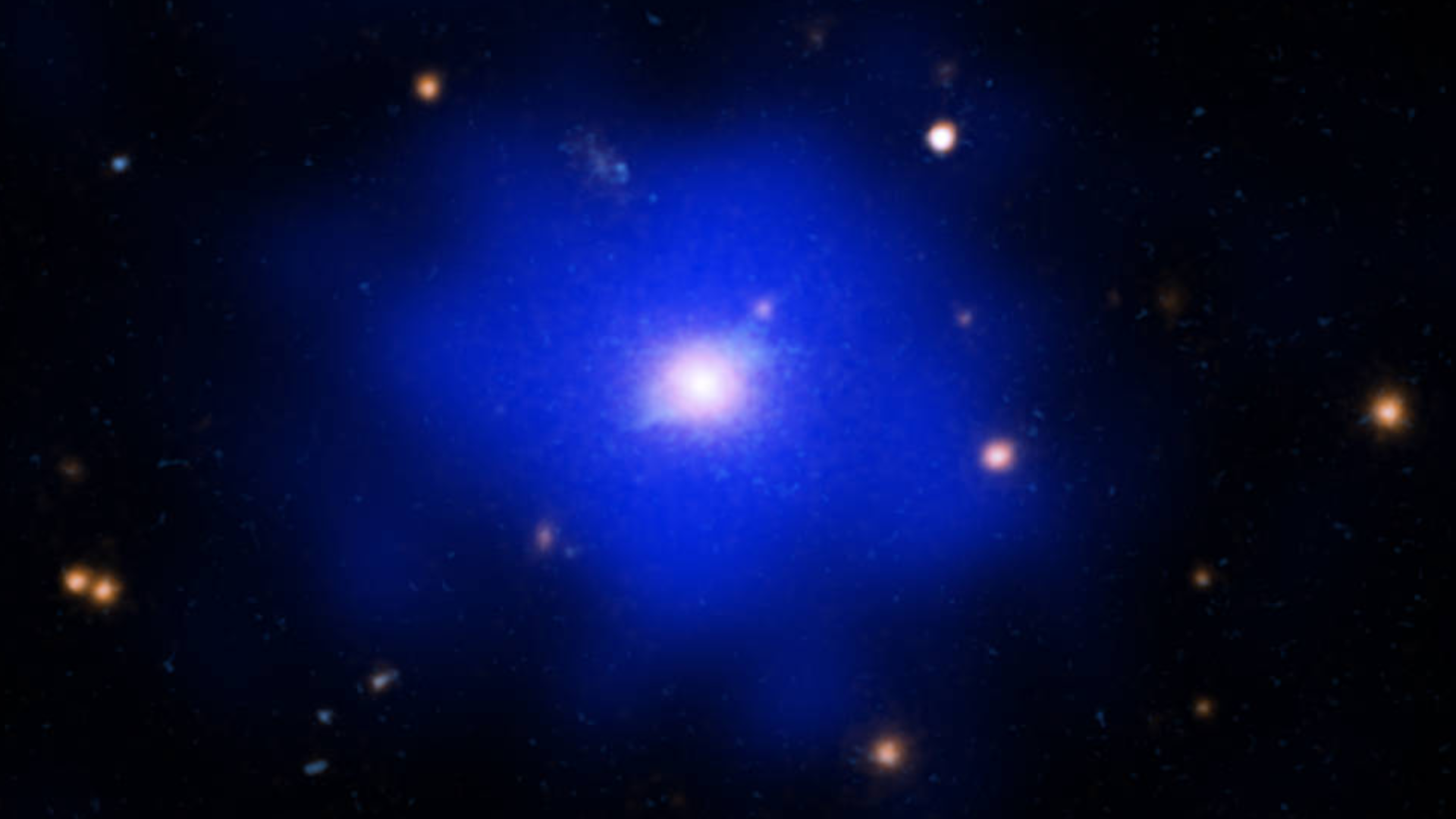
Astronomers have discovered a galaxy cluster that appears to be a virtual island of calm and tranquility amid the violent and chaotic early universe.
The cluster, called SPT-CL J2215-3537 (SPT2215 for short), lies 8.4 billion light-years away and is thus seen as it was when the universe, now 13.8 billion years old, was just 5.3 billion years old. Conditions at that time were generally turbulent in the cosmos, and galactic clusters — conglomerations of up to hundreds of galaxies with gas, dust and dark matter woven between them — that existed then were subject to frequent collisions and mergers.
The history of those violent interactions can be traced by detecting X-rays emitted by hot gas in the clusters. Studying those X-rays has revealed to scientists that while collisions frequently disrupted these clusters, they also facilitated their growth. That means observing such galaxy aggregates that existed during early cosmic history is crucial in understanding how the universe has evolved.
Related: Hubble telescope captures the making of a 'cosmic monster' (photo)
However, SPT2215 seems to buck this trend, representing a galactic cluster that appears to have gotten a head start on its formation when compared to similar clusters of the same size that existed in the universe at the at the same time. With a mass around 700 trillion times that of the sun, SPT2215 is estimated to have been "relaxing" for around a billion years at the time astronomers are viewing it.
"The fact that this cluster is so massive, so early in the universe suggests a really exciting, fast formation history," Lindsey Bleem, part of the team that spotted the cluster in 2020 and a researcher at the U.S. Department of Energy's Argonne National Laboratory, said in a statement. "Yet the fact that it is relaxed suggests the opposite. It would be like finding a tidy kitchen right after the dinner rush."
SPT2215 was spotted with NASA's Chandra X-ray Observatory, the space agency's now-retired Spitzer Space Telescope, the National Science Foundation/Department of Energy's South Pole Telescope, and the Dark Energy Survey project in Chile.
In addition to its "relaxed nature," the astronomers behind the discovery also noted other characteristics about the cluster, including the supermassive black hole that sits at its center.
A chilled supermassive black hole
Sitting at the heart of the cluster SPT2215 is a supermassive black hole with a relaxed vibe that reflects its wider surroundings. Although, the quiet nature of this cosmic titan significantly affects its host galaxy.
When supermassive black holes are active, and feed on material that surrounds them in a thin, circular structure called an accretion disk. This whole region emits a huge amount of energy, and that energy heats galactic gas and dust, thus preventing the materials from clumping. On the flip side, when black holes are inactive, gas and dust can cool and come together, forming large "clumps" that can collapse and birth stars.
This is another way SPT2215 differs from most relaxed galactic clusters seen by Chandra, which have black holes that are active, preventing gas from cooling and thus putting a cap on star formation.
The central galaxy of SPT2215 is also notable for its isolation from other galaxies in the cluster. There are no bright or elongated galaxies around it for around 600,000 light-years. This is significant because it implies that SPT2215 has not merged with another galactic cluster for at least a billion years.
Quite how this galactic cluster became relaxed just 5.3 billion years after the Big Bang while other clusters were smashing together and undergoing tumultuous growth is still a mystery. But despite the puzzling nature of this observation, it does conform with some recent findings from the James Webb Space Telescope (JWST), which indicate an unexpectedly large amount of galaxies forming and maturing in the young universe.
And one day, observations of these relaxed early galaxies could be key in understanding a pressing cosmic mystery. They could help scientists gauge the expansion of the universe and the effect of dark energy, a mysterious force accelerating that expansion.
"Relaxed clusters like SPT2215 are one of the signposts that have been used to measure the expansion of the universe," Stanford University researcher said Adam Mantz, who first reported SPT2215's relaxed status using Chandra data in 2022. "Adding distant objects like this to our sample of relaxed clusters allows us to better constrain the acceleration of the cosmic expansion and the properties of the dark energy that drives it."
The most recent paper describing SPT2215 is published in the Astrophysical Journal.







